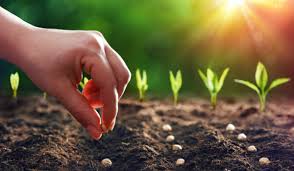Seeds and other planting materials are the basic foundation upon which successful crop production is laid. Failure in the choice of correct seeds, seed storage, time of planting, depth of planting, rate of seeding, and spacing could all lead to failure in the crop production enterprise.
In this article, all aspects of seeds and planting materials as they relate to quality, germination, storage of seeds, seed treatments, time of planting, seed rate, depth of planting, seed placement, seed emergence, and seedling vigor are treated.
Read Also: How To Grow Cassava
Definition of Sowing and Planting in Crop Establishment
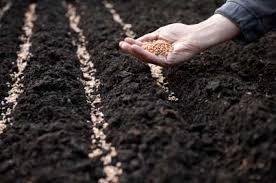
The establishment of field crops could either be from seeds or vegetative parts. The term sowing refers to seeds, while planting is used when vegetative parts are involved. Examples of crops established by sowing seeds include maize, groundnuts, sorghum, millet, wheat, cowpeas, and melon. Crops such as yams, sugarcane, ginger, sisal, cocoyam, sweet potatoes, and cassava are normally established by planting vegetative parts.
A seed consists of a miniature plant (the embryo) enclosed in a wrapper (the testa). Sometimes a quantity of nutritive material (the endosperm) may also be enclosed in the wrapper. The embryo represents the new generation of the plant and is the most essential part of the seed.
It consists of a shoot axis (the plumule), a root axis (the radicle), and one or more seed leaves (the cotyledons). In seeds where the endosperm is absent, much of the food material is stored in the cotyledons. The testa is the outer covering of the seed and usually encloses the seed entirely except for a minute pore.
Germination of Seeds
The process of germination involves the growth of the miniature plant (embryo) contained within the seed into a larger plant. The main function of the endosperm, where present, is to supply food materials to the growing embryo. The first event that occurs after a seed is sown in moist soil is that the seed imbibes water.
This process causes the seed to swell and results in the activation of various enzyme systems in the seed. Following the intake of water, the food material present in the seed is hydrolyzed. The products of hydrolysis are then translocated to the growing points, where they are used as building blocks for new cells and as substrates for respiration to supply energy for various processes.
Conditions Necessary for Germination
For seeds to germinate, certain environmental conditions must be fulfilled:
1. Water: Water must be available so that when it is imbibed by the seed, metabolic processes within the seed are enhanced.
2. Oxygen: Oxygen should be present for aerobic respiration to occur, supplying energy for the germination process.
3. Temperature: There should be an appropriate temperature.
Types of Germination
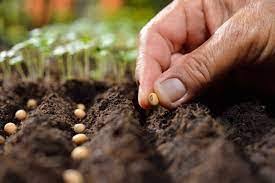
The morphological changes occurring during germination vary greatly from seed to seed. In some, the cotyledons are carried above ground level due to elongation of the region just below the cotyledons (hypocotyl). Seedlings whose germination occurs in this way are classified as epigeal germination.
The seedlings of groundnuts, melon, cowpea, onion, okra, and castor are all epigeal. In contrast to epigeal seedlings are those in which the cotyledons remain at the level where the seed was planted and are not carried above ground. Such seedlings exhibit hypogeal germination. Rice, maize, guinea corn, rubber, and broad bean seedlings are all examples of hypogeal germination.
Seed Dormancy
When a living seed fails to germinate even when provided with the normal conditions necessary for germination, such a seed is said to be dormant.
A. Causes of Seed Dormancy
1. Impermeable testa: The presence of an impermeable testa may prevent the intake of water and probably oxygen.
2. Growth inhibitors: The presence of growth inhibitors in the seed.
3. Cold treatment or photoperiods: It may be caused by the need for cold treatment or exposure to certain photoperiods before the seed can germinate.
4. Immature embryos: The embryo is still immature and has not yet reached its full development at the time of harvest.
5. High temperatures during maturity: Very high temperatures during seed maturity may induce dormancy in some species.
B. Measures to Overcome Seed Dormancy
1. After-ripening treatment: One type of primary dormancy is characterized by immature embryos. Although the seeds are shed by the plant, the embryo must continue to develop before germination will occur. Problems of immature embryos can be overcome if the seeds receive appropriate after-ripening treatment. Often, high temperatures are required for after-ripening. Certain palm seeds require 38°C to 40°C for three months.
2. Stratification: Seeds of many plants require moist chilling conditions for a period of time to render them capable of germination. This process is called stratification. Chilling is usually at 0°C to 10°C for 7 to 180 days. For example, apple seeds require up to 60 days in a moist medium at 3°C to 5°C to overcome dormancy.
3. Scarification: Seeds of some plant species have a very hard covering that may prevent them from germinating unless treated. A hard seed covering can prevent absorption of water and gaseous exchange or physically prevent the embryo from growing and emerging through the seed coat. It is therefore necessary to weaken these coverings or make them pervious to water and gases through the process of scarification.
4. Light: Light is essential for the seed germination of certain species of lettuce (positively photoblastic). If light is required, seeds should be sown shallowly. Some species, such as tomato and some lilies, are negatively photoblastic (their germination is inhibited by light) and should be sown more deeply for good germination.
Read Also: How To Make Cassava Bread Recipe
Vernalisation of Seeds
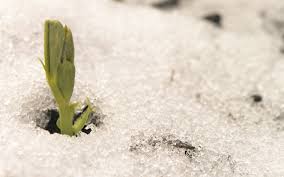
Temperatures significantly affect the time of flowering in many plants. Winter varieties of cereal crops behave like spring varieties when the seeds are germinated at temperatures slightly above freezing before sowing. This process is called vernalisation.
Methods of Seed Scarification
1. Acid Scarification: Seeds can be scarified by soaking them in concentrated sulfuric acid for a period ranging from a few minutes to an hour or more.
2. Hot Water Soak: Another method involves heating water to boiling point, adding the seeds, and removing them when the water cools 12-24 hours later.
3. Dry Heat: Dry heat can rupture the seed coats of some species.
4. Mechanical Scarifier: Mechanical scarifiers can scratch the seed coats. Since scarified seeds deteriorate rapidly, they should be planted immediately.
5. Aging: Natural deterioration of the seed coat can occur during dry storage. In an experiment with alfalfa, half of the impermeable seeds germinated after one and a half years, and all seeds germinated after eleven years in storage.
6. Freezing and Thawing: Alternating freezing and thawing sometimes stimulates germination of hard seeds like alfalfa and sweet clover.
7. Infrared Rays and Electric Energy: The germination of hard seeds of alfalfa or clover can be achieved by exposure to infrared rays for 1 to 1.5 seconds at a wavelength of 1180 millimicrons or by a few seconds of exposure to high-frequency electric energy.
Seed Quality
Several factors affect seed quality, including maturity, wholesomeness, diseases, pests, and foreign matter.
1. Maturity: Immature seeds tend to store poorly and may fail to germinate. The stage of maturity at harvest and the conditions during maturity are crucial for seed quality.
2. Wholesomeness: Injury, cracking, or breakage of seeds can reduce germination rates. Injuries to the endosperm or cotyledons may impair germination only slightly, but damage to the plumule-radicle axis may prevent germination entirely.
Mechanical injuries can also make seeds susceptible to diseases and pests, reducing their storability. Wholesomeness is important for both sowing and market value.
3. Diseases and Pests: Diseases can give seeds an unpleasant odor and taste, while pests may consume or degrade the seeds. Diseased seeds germinate poorly, and pests like cowpea weevils can cause significant damage. Seeds are often treated with pesticides to protect them, a process known as seed dressing.
4. Foreign Matter: The presence of foreign matter, such as stones or dried plant material, reduces seed quality. Weed seeds pose additional problems when sown and can promote spoilage during storage.
Seed Certification
In Africa, seed quality is overseen by agencies like the National Seed Service in Nigeria. Their responsibilities include monitoring seed production locations, grading seeds, conducting viability and germination tests, certifying seeds, and distributing certified seeds.
Classes of Seeds
1. Breeder Seeds: These provide the source for the initial and recurring increase of foundation seeds and are directly controlled by the originator or the sponsoring institution.
2. Foundation Seeds: These are the source of all other certified seed classes and are handled to maintain genetic identity and purity as prescribed by agricultural experimental stations.
3. Registered Seeds: These are the progeny of foundation or registered seeds and are certified for quality suitable for producing certified seeds.
4. Certified Seeds: Certified seeds are the progeny of foundation, registered, or certified seeds that maintain satisfactory genetic identity and purity, approved and certified by the certifying agency.
Seed Storage
The optimum conditions for storing seeds for long-term storage include:
1. Moisture: Drying the seed to 5-7% moisture content.
2. Oxygen: Sealed storage in the absence of oxygen.
3. Temperature: A storage temperature of 7.5° to 15°C.
Most seeds store well in cool, dry conditions, but some may lose viability if dried too much. The life of seeds doubles with each 10% decrease in moisture content or 10°C drop in temperature. Most seeds can be stored at –18°C for long periods. Some seeds, like citrus and chestnut, require moist, refrigerated conditions.
Seed Treatments
Diseases and pests may be seed-borne, making seed treatment necessary.
1. Surface Treatment: Seed-borne diseases on the seed surface may be controlled with chemicals like copper sulfate, formaldehyde, or copper oxide. These treatments can also protect young seedlings from soil-borne diseases during germination.
2. Hot Water Treatment: When disease-causing organisms are beneath the seed coat, surface treatments may be ineffective. Hot water treatments can kill the disease without harming the seeds.
3. Fumigation: Weevils in beans can be controlled through fumigation with formaldehyde. Untreated seeds may harbor pests that destroy the seeds from within.
4. Pelleted Seeds: Small or irregular seeds may be pelleted with materials containing fungicides or growth stimulants. Pelleted seeds are easier to sow at regular intervals, improving sowing efficiency and results.
Time of Sowing or Planting
Several factors influence the time of sowing or planting, including:
1. Rainfall: The availability of moisture is a primary factor. Long-season crops like yams must be planted early in the rainy season, while short-season crops like cowpeas or maize can be planted later.
2. Temperature: In the tropics, high temperatures can affect seedling emergence.
3. Day Length: The photoperiod affects the flowering or tubering stages of crops like okra. Varieties requiring short days should be planted accordingly to ensure proper flowering conditions.
Occurrence of Diseases and Pests
The timing of planting can be influenced by the prevalence of diseases and pests. Adjusting the planting schedule allows crops to grow when the occurrence of diseases and pests is minimal.
For example, cowpea production in southern Nigeria is heavily influenced by pest pressure. Early sowing during the rainy season exposes the crop to numerous diseases and pests. However, sowing in the latter half of the rainy season reduces the incidence of these challenges, resulting in better yields.
Marketing
Marketing factors may also dictate planting time, ensuring crops are ready for harvest when market prices are favorable. This is especially true for perishable crops like vegetables, which cannot be stored for extended periods and must be sold soon after harvest for maximum profit.
Cropping System
The crop’s place in a rotation or intercropping system can also determine planting time. In West Africa, cassava is often planted later in the rainy season after early intercrops like maize, okra, and melon have been harvested. Although cassava could be planted earlier, farmers wait to ensure there is adequate space left by earlier harvested crops.
Methods of Seed Planting
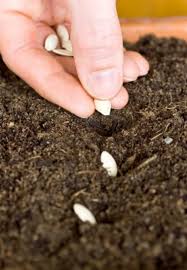
Field crops can be planted using the following methods:
1. Broadcasting: This involves scattering seeds randomly across the field without adhering to specific row or spacing patterns. Common crops sown by this method include rice, wheat, sesame, and some vegetables.
2. Drilling Method: Seeds are placed in shallow furrows created by a hoe or disc and covered with soil. Spacing between plants may not be strictly regulated, and it is often used for several field crops.
3. Precision Planting: This method involves planting crops like maize, sorghum, and millet at fixed intra and inter-row spacing, ensuring optimal plant density, productivity, and high yields.
4. Transplanting: Crops like tobacco, tomato, pepper, and vegetables are often raised in nurseries before being transplanted to the field. This method helps conserve seeds and ensures that only healthy seedlings are transplanted for maximum success.
Factors Determining Choice of Planting Method
The following factors influence the choice of planting method:
1. Seed Size: Larger seeds are better suited for deeper planting, while smaller seeds are often planted shallowly.
2. Growth Habit of Plant: Some plants require specific methods based on their growth patterns.
3. Seedbed Preparation: The condition of the seedbed can dictate the most suitable planting method.
4. Climatic Condition: Weather patterns and moisture availability can affect planting choices.
5. Labour Availability: The method selected may depend on the number of workers available for planting.
6. Seed Placement in the Field: How the seeds are positioned (ridge, furrow, mound) plays a role in choosing the right planting method.
Seed Placement Considerations
When planting, the following aspects are important:
1. Number of Seeds per Stand: This is influenced by germination rates and the number of plants needed per stand. Over-seeding followed by thinning ensures the healthiest seedlings remain and helps guarantee optimal plant populations.
2. Spacing Between Stands: This depends on the crop’s root and shoot system. Larger plants require more space, while smaller plants can be placed closer together. Precision in row spacing also allows mechanical planters to operate efficiently.
3. Depth of Sowing Seeds: Factors influencing sowing depth include:
i. Seed Size: Larger seeds can be sown deeper, while smaller seeds need to be placed closer to the surface.
ii. Type of Germination: Seeds with epigeal germination may struggle to emerge from great depths.
iii. Moisture Status of Soil: Deeper planting may be required in dry conditions to access moist soil.
iv. Soil Type: Seeds can generally emerge from deeper depths in sandy soils than in clay soils.
Position of Seeds in Respect to Land Preparation
The position of seeds (ridge, furrow, or flat) depends on environmental conditions. In waterlogged areas, seeds are placed on ridges, while in dry areas, furrows may help retain moisture.
Seed Emergence and Seedling Vigour
Seedling emergence is crucial as it assures farmers of successful germination. The following factors affect emergence:
i. Temperature: Higher or lower temperatures can influence the speed and success of germination.
ii. Time to Germination: Seeds that germinate quickly allow seedlings to establish before seed reserves are depleted.
iii. Sowing Depth: Shallow sowing ensures faster emergence.
iv. Soil Condition: Light, loose soils encourage quick emergence, while crusted soils may hinder it.
v. Seedling Vigour: The health and vigor of seedlings depend on seed quality, soil conditions, and environmental factors.
Poor emergence can result from low germination rates, improper sowing depth, or disease and pest attacks. Uniform emergence ensures all plants grow at the same rate, aiding in better management practices, such as fertilization and harvesting.
Factors Affecting Uniformity of Emergence
Uniform emergence relies on:
i. Consistent germination rates
ii. Using non-dormant seeds
iii. Managing environmental conditions effectively
Seedling Vigour
High seedling vigor contributes to better crop establishment. Factors that may lower seedling vigor include small seed size, the presence of pathogens, long storage periods, or adverse environmental conditions during germination.
Planting quality seeds and materials is critical for achieving high yields. Proper seed selection, placement, and land preparation practices ensure strong germination, emergence, and seedling vigor, which ultimately lead to better crop performance and productivity.
Do you have any questions, suggestions, or contributions? If so, please feel free to use the comment box below to share your thoughts. We also encourage you to kindly share this information with others who might benefit from it. Since we can’t reach everyone at once, we truly appreciate your help in spreading the word. Thank you so much for your support and for sharing!

